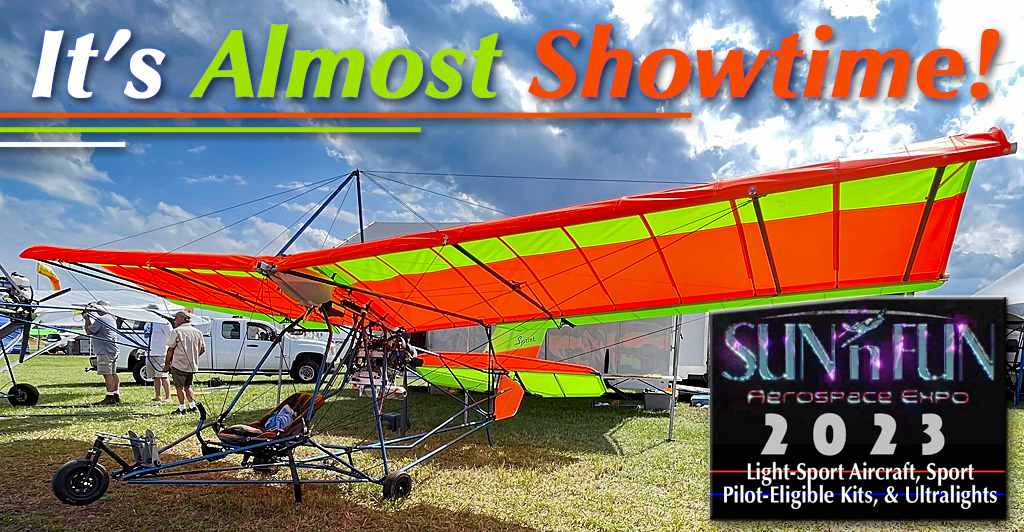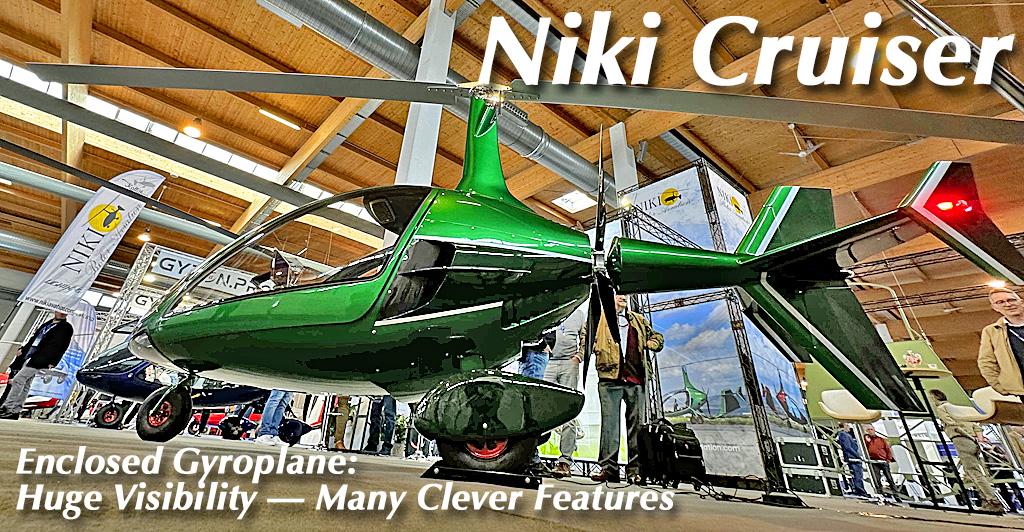 If the bright green didn’t catch your eye, the unusual placement of the propeller probably did. Or maybe it was one of a dozen other fetching attributes to this handsome rotary-winged aircraft.
What you could not easily see was the engine selection. As up-to-date as they can be, Niki is offering either a 141-horsepower Rotax 915iS or the just-released 160-horsepower 916iS. The latter with a lighter load can reportedly climb better than 2,500 feet per minute.
As I cruised the immense (basketball gymnasium-sized) halls of Aero 2023, I saw all manner of beautiful flying machines. In four days of the show, I find it unlikely you can even visit all of them much less become well informed about a majority.
When I happened across Niki, I remembered they had sent an invitation to come by and look at their engaging designs. Company co-owner Miglena Kopcheva was kind enough to show me around the green machine you see nearby.
If the bright green didn’t catch your eye, the unusual placement of the propeller probably did. Or maybe it was one of a dozen other fetching attributes to this handsome rotary-winged aircraft.
What you could not easily see was the engine selection. As up-to-date as they can be, Niki is offering either a 141-horsepower Rotax 915iS or the just-released 160-horsepower 916iS. The latter with a lighter load can reportedly climb better than 2,500 feet per minute.
As I cruised the immense (basketball gymnasium-sized) halls of Aero 2023, I saw all manner of beautiful flying machines. In four days of the show, I find it unlikely you can even visit all of them much less become well informed about a majority.
When I happened across Niki, I remembered they had sent an invitation to come by and look at their engaging designs. Company co-owner Miglena Kopcheva was kind enough to show me around the green machine you see nearby.Aero ’23 Continued — Superpowered Niki Aviation Cruiser Gyroplane Shows Stylish Innovation
If the bright green didn’t catch your eye, the unusual placement of the propeller probably did. Or maybe it was one of a dozen other fetching attributes to this handsome rotary-winged aircraft.
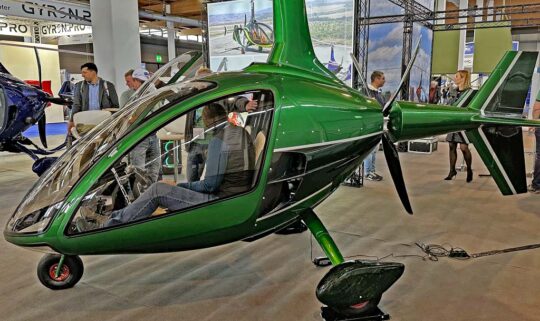
As I cruised the immense (basketball gymnasium-sized) halls of Aero 2023, I saw all manner of beautiful flying machines. In four days of the show, I find it unlikely you can even visit all of them much less become well informed about a majority.

Forty aircraft are flying at this time but Cruiser is poised to boost numbers. The muscular choice of Rotax’s two most powerful engines will position this gyroplane near the top of the category.
Introducing
Niki’s Cruiser
Niki Aviation — more fully, Niki Rotor Aviation or NRA — is a family-owned company established in 2010 in Pravets, a picturesque small town 60 kilometers from Bulgaria’s capital, Sofia. The company proudly added, “Bulgaria is a small country famous for its engineering, beautiful nature, and friendly people.” A nation of about seven million population, Bulgaria is northeast of Greece and northwest of Turkey. Although its eastern shores share the Black Sea with Ukraine, it is a long way from that conflict.
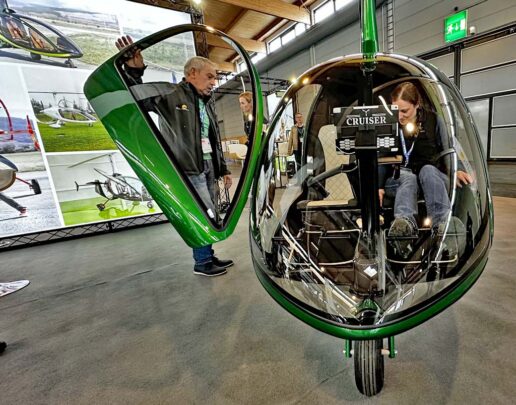

The company’s first project was the Niki 2004 gyroplane that successfully accomplished it first flight test in December, 2008 in Montana, Gabrovnitsa airfield in Bulgaria. The first market-ready gyroplane was Lightning, followed by Kallithea— both feature tandem seating — and most recently by Cruiser.

Additional storage is available by lifting the seat cushion; not accessible in-flight.
Today’s Cruiser model offers side-by-side seating and the cleanest tail assembly among gyroplanes with ample area well aft to aid stability. Cruise is visually very tidy and clean.
“The final touch of [our] gyroplanes is something that will take your breath away — elegant shapes, clean work, hand-made parts, excellent lacquering, and luxurious interiors with hand-made stitches, proudly stated Niki. “Our machine, your unique personality.”
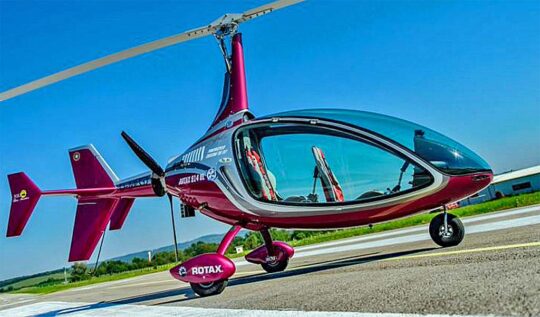
Niki’s first marketed gyroplane, Lightning.
Continuing to explain their attention-generating new model, Niki said, “Cruiser combines outstanding design due to the tail construction concept (which also appeared on their Lightning model) and gives breathtaking view from the cockpit. The machine has a comfortable seating and luggage compartment which makes the gyroplane unique for a weekend trip.” They note it is built from a fully carbon fuselage and engine frame to give extremely light construction.
Niki also calls a 12.9-inch iPad their “Portable Navigation system” offering “Flight View EFIS” software. The easily-detached device provides flexibility to combine work and pleasure. Using iPad as a cockpit instrument is common among LSA and Sport Pilot kit aircraft, though going with Apple’s largest model conforms to the highly-stylized interior aboard Niki Cruiser.

The sporty-looking shape of Kallithea.
NRA is especially proud of their innovative rotor head developed and designed in-house; a titanium exhaust system; Beringer brakes; removable doors; foldable mast for easy transportation and parking; adjustable seats and pedals, and Niki claims, “No stick shake,” addressing one of the most common concerns from fixed wing pilots checking out in a gyroplane. [I have no independent verification for the last claim.]
TECHNICAL SPECIFICATIONS
Niki Rotor Aviation Cruiser
all specification provided by the manufacturer
- Empty Weight — 661 pounds
- Maximum Takeoff Weight — 1,320 pounds
- Length — 15.4 feet
- Height — 9.5 feet
- Propeller Diameter — 70 inches
- Rotor Diameter — 28.9 feet
- Rotor Chord — 8.25 inches
- Engine Type — Rotax 915iS or 916iS
- Power Output — 141 or 160 horsepower
- Fuel Capacity — 2 tanks at 10.5 gallons each, 21 gallons total
- Fuel Consumption— 5.25 gallons per hour
- Endurance at Cruise Power — 5 hours with 30 minute reserve
- Pre-rotator Rotation — 200-300 revolutions per minute
- Power Output — 12 volt
- Never-Exceed Speed — 100 knots
- Minimum Speed — 19 knots
- Cruise Speed — 75-85 knots
- Vertical Speed — 600-2,500 feet per minute
- Maximum Altitude — 11,500 feet
- Take-off Roll — 0-500 feet
- Landing Roll 0-65 feet
ARTICLE LINKS:
- Niki Rotor Aviation, company website
- L.A. Gyroplane Aviation, U.S. representative website
- Additional video, found at the bottom of this page for L.A. Gyroplane
The following company promo is mostly English with some subtitles. It was made before Cruiser was introduced but provides some of the company back story.
The company shows style not only in their aircraft design but in how they present their products. Here’s an example:
If you enjoy this image, find more here.
 If the bright green didn’t catch your eye, the unusual placement of the propeller probably did. Or maybe it was one of a dozen other fetching attributes to this handsome rotary-winged aircraft.
What you could not easily see was the engine selection. As up-to-date as they can be, Niki is offering either a 141-horsepower Rotax 915iS or the just-released 160-horsepower 916iS. The latter with a lighter load can reportedly climb better than 2,500 feet per minute.
As I cruised the immense (basketball gymnasium-sized) halls of Aero 2023, I saw all manner of beautiful flying machines. In four days of the show, I find it unlikely you can even visit all of them much less become well informed about a majority.
When I happened across Niki, I remembered they had sent an invitation to come by and look at their engaging designs. Company co-owner Miglena Kopcheva was kind enough to show me around the green machine you see nearby.
If the bright green didn’t catch your eye, the unusual placement of the propeller probably did. Or maybe it was one of a dozen other fetching attributes to this handsome rotary-winged aircraft.
What you could not easily see was the engine selection. As up-to-date as they can be, Niki is offering either a 141-horsepower Rotax 915iS or the just-released 160-horsepower 916iS. The latter with a lighter load can reportedly climb better than 2,500 feet per minute.
As I cruised the immense (basketball gymnasium-sized) halls of Aero 2023, I saw all manner of beautiful flying machines. In four days of the show, I find it unlikely you can even visit all of them much less become well informed about a majority.
When I happened across Niki, I remembered they had sent an invitation to come by and look at their engaging designs. Company co-owner Miglena Kopcheva was kind enough to show me around the green machine you see nearby.


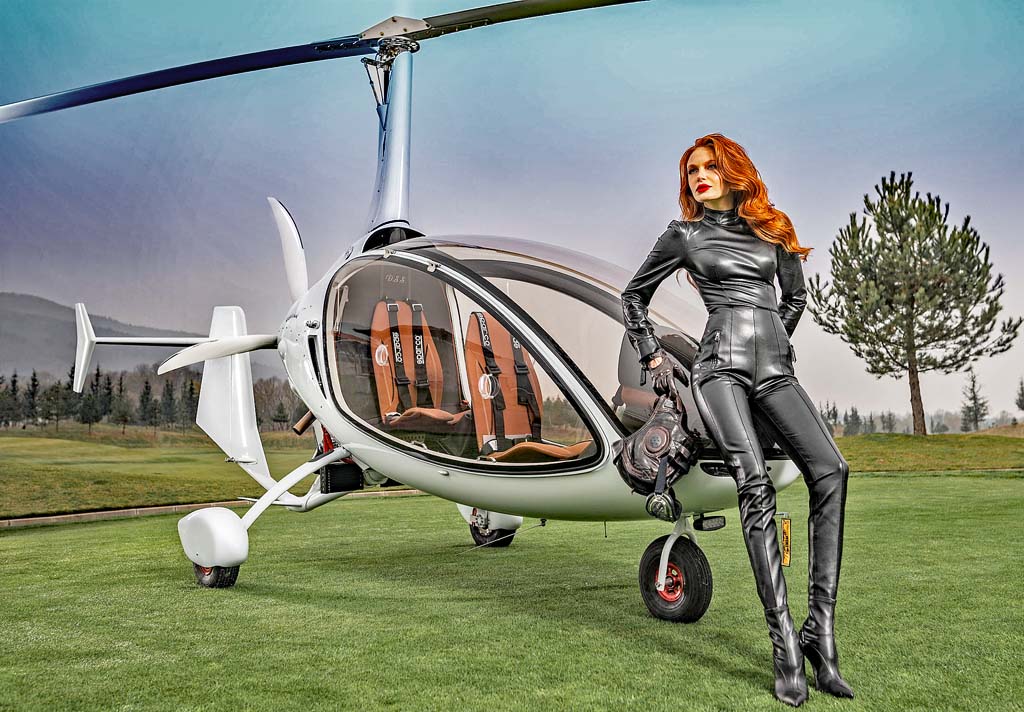
 So, flying a Zeppelin. Cool, yes, but you’re only a passenger. Sure, the visibility is fantastic through panoramic (and German-clean) windows, and every seat is a window seat. But aren’t you stuck in that one seat the whole flight? Nope.
So, flying a Zeppelin. Cool, yes, but you’re only a passenger. Sure, the visibility is fantastic through panoramic (and German-clean) windows, and every seat is a window seat. But aren’t you stuck in that one seat the whole flight? Nope.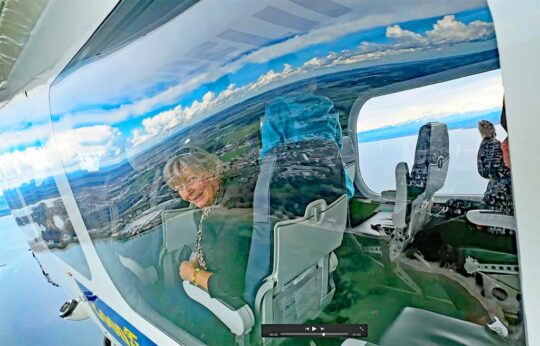 You fly around 35 knots (max is 67 knots). It feels remarkably like many ultralights I’ve flown, where the ground drifts by underneath. We flew around at about 1,000-1,500 feet so the sight was familiar to any recreational pilot.
You fly around 35 knots (max is 67 knots). It feels remarkably like many ultralights I’ve flown, where the ground drifts by underneath. We flew around at about 1,000-1,500 feet so the sight was familiar to any recreational pilot.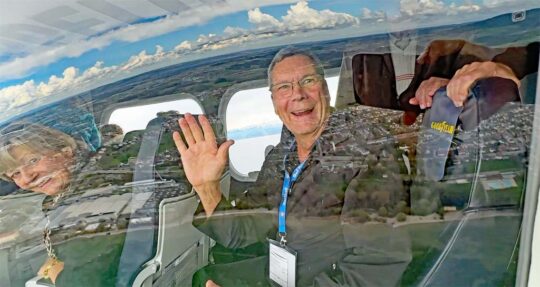

 Subsequently, Goodyear built 347 of their non-rigid blimps but when the last one operated to the end of its service life, Goodyear restored relations with Zeppelin and the aircraft in which I flew is one of three NTs built at Goodyear’s Akron, Ohio facility under the direction of Zeppelin using their semi-rigid construction.
Subsequently, Goodyear built 347 of their non-rigid blimps but when the last one operated to the end of its service life, Goodyear restored relations with Zeppelin and the aircraft in which I flew is one of three NTs built at Goodyear’s Akron, Ohio facility under the direction of Zeppelin using their semi-rigid construction. On prior years at Aero, I’ve seen several other corporate markings on Zeppelins. The Zeppelin NT is approved in Europe and the USA for passenger hauling, the first airship to be so licensed since the era of airships that ended with the Hindenburg disaster. Zeppelin NT uses nonflammable Helium, of course.
On prior years at Aero, I’ve seen several other corporate markings on Zeppelins. The Zeppelin NT is approved in Europe and the USA for passenger hauling, the first airship to be so licensed since the era of airships that ended with the Hindenburg disaster. Zeppelin NT uses nonflammable Helium, of course.

 One was easy to pick out as new. The other initially fooled me. In the Aero event I missed last year due to Covid (and the prior two years that were cancelled due to government Covid restrictions), AVI developers have been busy.
One was easy to pick out as new. The other initially fooled me. In the Aero event I missed last year due to Covid (and the prior two years that were cancelled due to government Covid restrictions), AVI developers have been busy.

 Under the cowling is… well, your choice. Both new AVI models offer the Polini 303 with 38 horsepower, making Swan lively and able to achieve short takeoffs. Or, you can have an equally powerful (28 kW or 37.5 hp) electric propulsion unit. AVI has offered electric for several years, time enough to work out the installation and operation.
Under the cowling is… well, your choice. Both new AVI models offer the Polini 303 with 38 horsepower, making Swan lively and able to achieve short takeoffs. Or, you can have an equally powerful (28 kW or 37.5 hp) electric propulsion unit. AVI has offered electric for several years, time enough to work out the installation and operation. Swan at Aero was badged “Swan 120 LE” as it is approved under Germany’s 120-Kilo Class. However, in our discussion, Radu stressed more than once that both Swan and Dracula can conform to U.S. Part 103 with minor changes, which he has already engineered and produced. The earlier boom-engine Swan has already proved itself capable of meeting Part 103, according to importer Tom Bartlett, AVI Aircraft’s U.S. distributor (
Swan at Aero was badged “Swan 120 LE” as it is approved under Germany’s 120-Kilo Class. However, in our discussion, Radu stressed more than once that both Swan and Dracula can conform to U.S. Part 103 with minor changes, which he has already engineered and produced. The earlier boom-engine Swan has already proved itself capable of meeting Part 103, according to importer Tom Bartlett, AVI Aircraft’s U.S. distributor ( One example is the wing-remove, tail-boom-fold method of disassembling Dracula for transport. Radu indicated that Dracula would fit the impossibly-small trailer just as Swan LE does. Given significant waits for hangar space at many airports, a small trailer could be the deciding factor for some potential buyers. Towing this small trailer around, almost no one would believe you have an airplane inside. A small trailer is also lightweight so towing with a smaller vehicle should not prove challenging.
One example is the wing-remove, tail-boom-fold method of disassembling Dracula for transport. Radu indicated that Dracula would fit the impossibly-small trailer just as Swan LE does. Given significant waits for hangar space at many airports, a small trailer could be the deciding factor for some potential buyers. Towing this small trailer around, almost no one would believe you have an airplane inside. A small trailer is also lightweight so towing with a smaller vehicle should not prove challenging.

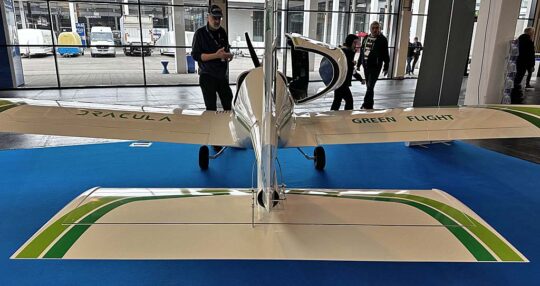 What else does AVI do?
What else does AVI do?
 I was alerted to visit Belmont by my journalist friend, Marino Boric, who suggested I have a look at Belmont primarily because it carries quite an agreeable price point: €96,000. At today’s exchange rate ($1 = €1.09), that translates to $105,000 before shipping and related transport expenses.
I was alerted to visit Belmont by my journalist friend, Marino Boric, who suggested I have a look at Belmont primarily because it carries quite an agreeable price point: €96,000. At today’s exchange rate ($1 = €1.09), that translates to $105,000 before shipping and related transport expenses.
 “DW200 is a two-seat, all-metal, low-wing aircraft with side-by-side seats,” said Belmont. “The landing gear consists of a fixed tricycle landing gear with steerable nose wheel.”
“DW200 is a two-seat, all-metal, low-wing aircraft with side-by-side seats,” said Belmont. “The landing gear consists of a fixed tricycle landing gear with steerable nose wheel.”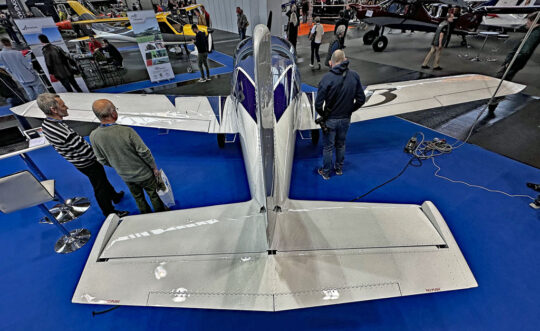 This
This  Belmont’s wing is all-metal with a rectangular center section and trapezoidal outer sections. All elements are made of aluminum, which may assure some readers concerned with repairs for an aircraft with a distant origin.
Belmont’s wing is all-metal with a rectangular center section and trapezoidal outer sections. All elements are made of aluminum, which may assure some readers concerned with repairs for an aircraft with a distant origin. Beautifully upholstered seats have a composite sandwich structure. Four-point seat belts are standard. Headphone jacks are located behind the pilot’s seats.
Beautifully upholstered seats have a composite sandwich structure. Four-point seat belts are standard. Headphone jacks are located behind the pilot’s seats. Belmont DW200 presented well at Aero and looked top quality on display. The company’s base price appears reasonable in an age that has seen several LSA cross the $300,000 border. I believe it’s fair to call Belmont “affordable.”
Belmont DW200 presented well at Aero and looked top quality on display. The company’s base price appears reasonable in an age that has seen several LSA cross the $300,000 border. I believe it’s fair to call Belmont “affordable.”
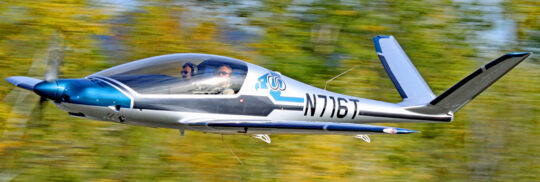 What could the typical pilot expect while flying Superveloce? Porto Aviation lists the cruise speed at 75% power from Rotax’s 915iS at 200 knots true airspeed at 9,000 feet. Compared to other LSA I have examined, this tops the list (although some other fast designs aren’t too far behind).
What could the typical pilot expect while flying Superveloce? Porto Aviation lists the cruise speed at 75% power from Rotax’s 915iS at 200 knots true airspeed at 9,000 feet. Compared to other LSA I have examined, this tops the list (although some other fast designs aren’t too far behind). Isn’t this well beyond LSA speeds?
Isn’t this well beyond LSA speeds? How fast is this aircraft?
How fast is this aircraft?
 For complete factory information on speeds, see the data sheet below. Note the right column portrays Risen 915iS SV — with “SV” designating Superveloce. Even with the less costly and more fuel efficient 912iS, Risen can still hit 162 knots at 9,000 feet.
For complete factory information on speeds, see the data sheet below. Note the right column portrays Risen 915iS SV — with “SV” designating Superveloce. Even with the less costly and more fuel efficient 912iS, Risen can still hit 162 knots at 9,000 feet.

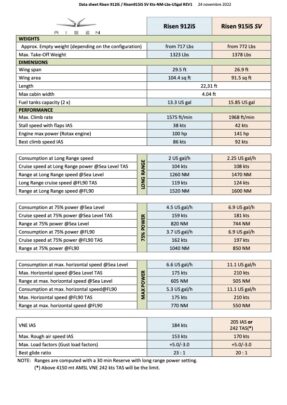




 As airframe producers made the effort to configure the new engine to their aircraft, its appearance is becoming more common.
As airframe producers made the effort to configure the new engine to their aircraft, its appearance is becoming more common. These are somewhat specialized aircraft and they may take a certain kind of buyer. However, you cannot fault the exquisite design effort and the painstaking detail that shows in the construction.
These are somewhat specialized aircraft and they may take a certain kind of buyer. However, you cannot fault the exquisite design effort and the painstaking detail that shows in the construction.

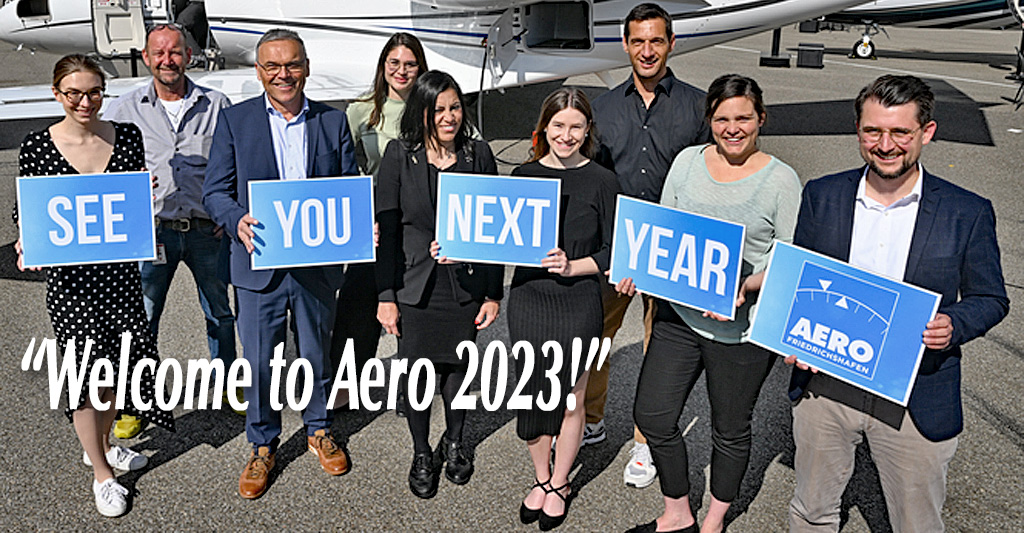

 Beringer and its team of 32 employees, has progressively moved up in the ranks of widely-used wheel and brake systems, distinguishing themselves by the safety, reliability, and innovation of its distinctively-colored products.
Beringer and its team of 32 employees, has progressively moved up in the ranks of widely-used wheel and brake systems, distinguishing themselves by the safety, reliability, and innovation of its distinctively-colored products. The leaders of Beringer reported, “We did not set out to create ‘good enough’ wheels and brakes. We sought to create exceptional wheels and brakes, with the goal of providing peace of mind to pilots during the most critical phases of flight.” Smart, because while pilots love to go fast, they definitely appreciate a strong set of brakes at the end of the flight.
The leaders of Beringer reported, “We did not set out to create ‘good enough’ wheels and brakes. We sought to create exceptional wheels and brakes, with the goal of providing peace of mind to pilots during the most critical phases of flight.” Smart, because while pilots love to go fast, they definitely appreciate a strong set of brakes at the end of the flight. “Representing a culmination of decades of production, testing, and experience, Aerotec+ offers a fundamentally new package designed for safety and increased performance,” said Beringer.
“Representing a culmination of decades of production, testing, and experience, Aerotec+ offers a fundamentally new package designed for safety and increased performance,” said Beringer.



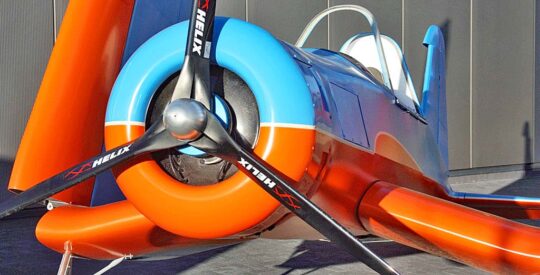 Then he finished the aircraft, flew it, and proved it could make weight. Later Jörg worked with a three-cylinder internal combustion engine that seemed to fit the era well. He wasn’t done as you’ll see below.
Then he finished the aircraft, flew it, and proved it could make weight. Later Jörg worked with a three-cylinder internal combustion engine that seemed to fit the era well. He wasn’t done as you’ll see below.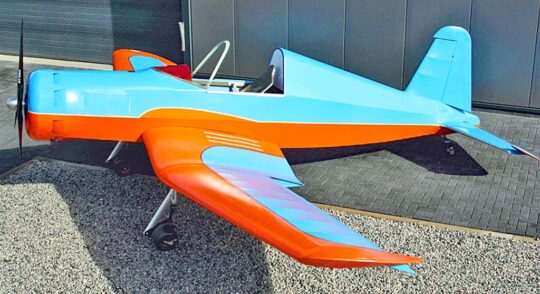
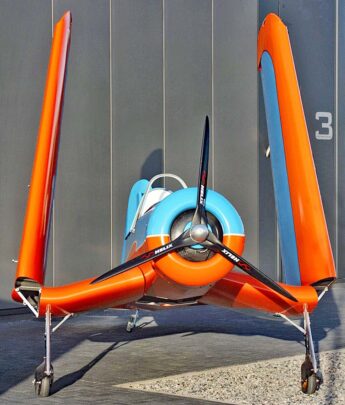

 As many who attended Sun ‘n Fun 2023 learned and even more discovered via online news — Flying Media has acquired the ByDanJohnson aviation brand and all of the written, photographic, or video content created under the tagline, “By Dan Johnson.”
As many who attended Sun ‘n Fun 2023 learned and even more discovered via online news — Flying Media has acquired the ByDanJohnson aviation brand and all of the written, photographic, or video content created under the tagline, “By Dan Johnson.” Building a website was very challenging then — we called it “stick-built,” as every line of code to make it work had to be written essentially from scratch. WordPress, which today delivers ByDanJohnson.com and about one-third of all websites worldwide, did not exist in 1999. Google was new. Facebook had yet to launch. No one had heard of YouTube. Apple’s iPhone was years away. Tick tock was something only a clock did. A lot happened in 20 years.
Building a website was very challenging then — we called it “stick-built,” as every line of code to make it work had to be written essentially from scratch. WordPress, which today delivers ByDanJohnson.com and about one-third of all websites worldwide, did not exist in 1999. Google was new. Facebook had yet to launch. No one had heard of YouTube. Apple’s iPhone was years away. Tick tock was something only a clock did. A lot happened in 20 years. As Flying takes completes its takeover around April 1, 2024, ByDanJohnson.com will complete a full 20 years of publishing… an eternity in Internet time. Flying will rebadge ByDanJohnson.com as AffordableAviation.com. I purchased this website domain name many years ago with exactly this change in mind.
As Flying takes completes its takeover around April 1, 2024, ByDanJohnson.com will complete a full 20 years of publishing… an eternity in Internet time. Flying will rebadge ByDanJohnson.com as AffordableAviation.com. I purchased this website domain name many years ago with exactly this change in mind.

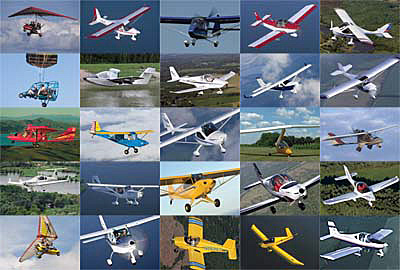 “The LSA category is the most exciting part of the aviation industry,” Craig said in Flying’s announcement. “It offers affordable access to some of the most advanced general aviation aircraft in the market. With the changes expected under Mosaic, we expect an explosion in new aircraft models, innovative technology, and more affordable offerings for pilots and aircraft owners. Affordable aviation is coming to general aviation and Flying Media Group plans to capitalize on this opportunity by providing far more coverage and content related to the category, across all of our channels.”
“The LSA category is the most exciting part of the aviation industry,” Craig said in Flying’s announcement. “It offers affordable access to some of the most advanced general aviation aircraft in the market. With the changes expected under Mosaic, we expect an explosion in new aircraft models, innovative technology, and more affordable offerings for pilots and aircraft owners. Affordable aviation is coming to general aviation and Flying Media Group plans to capitalize on this opportunity by providing far more coverage and content related to the category, across all of our channels.” Part 103 ultralights — that nobody, including me, can count accurately — appear to be doing very well. Light-Sport Aircraft and Sport Pilot kit-built aircraft were
Part 103 ultralights — that nobody, including me, can count accurately — appear to be doing very well. Light-Sport Aircraft and Sport Pilot kit-built aircraft were 
 Since it wasn’t side by side that did it, was it the way the canopy seemed to hinge forward and nearly off? Was it the dual-boom empennage?
Since it wasn’t side by side that did it, was it the way the canopy seemed to hinge forward and nearly off? Was it the dual-boom empennage?
 Jindrich and Ondrej could see what the other side-by-side gyro producers were doing and they clearly set out to further those design efforts. The earlier designs simply don’t have all the innovative ideas that Nisus does.
Jindrich and Ondrej could see what the other side-by-side gyro producers were doing and they clearly set out to further those design efforts. The earlier designs simply don’t have all the innovative ideas that Nisus does.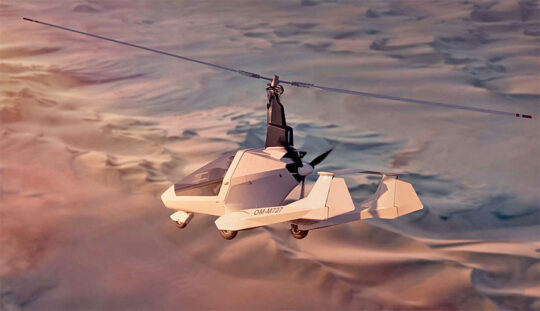 Nisus uses a primary structure welded from chrome molybdenum steel tubes (25crmo4 NBK), reducing weight while ensuring a rigid form and enhanced safety. The inside of the cabin is fully layered with a carbon Kevlar hybrid for occupant safety.
Nisus uses a primary structure welded from chrome molybdenum steel tubes (25crmo4 NBK), reducing weight while ensuring a rigid form and enhanced safety. The inside of the cabin is fully layered with a carbon Kevlar hybrid for occupant safety. ✔️ Simple but necessary. How do you tie down a gyroplane. Not by its “wings.” Instead, Nisus provides tie downs on all three wheels.
✔️ Simple but necessary. How do you tie down a gyroplane. Not by its “wings.” Instead, Nisus provides tie downs on all three wheels.
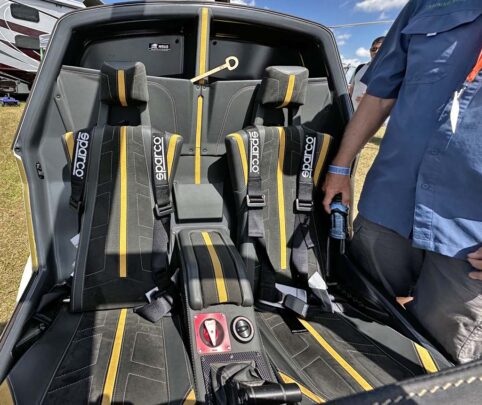
 ✔️ Nisus uses an integrated throttle, wheel-brake lever, and prerotator handle grouped for one-hand operation. Rich said that Nisus prerotator spins up the rotor quickly (15-20 seconds) and you can go full power as this happens. With a simple hand gesture, you can relax the wheel brake and release the prerotator without removing your hand from the throttle. This makes great sense in an important phase of flight.
✔️ Nisus uses an integrated throttle, wheel-brake lever, and prerotator handle grouped for one-hand operation. Rich said that Nisus prerotator spins up the rotor quickly (15-20 seconds) and you can go full power as this happens. With a simple hand gesture, you can relax the wheel brake and release the prerotator without removing your hand from the throttle. This makes great sense in an important phase of flight.


 Let’s begin with a focus on the modest cost of Merlin. I promote affordable aviation all day long. That word “affordable” means something different to every single pilot so every time I use the word someone is going to tell me, “It’s still too expensive.”
Let’s begin with a focus on the modest cost of Merlin. I promote affordable aviation all day long. That word “affordable” means something different to every single pilot so every time I use the word someone is going to tell me, “It’s still too expensive.” Look I get it. I’m a consumer, too. Plus, who doesn’t enjoy a deal? So here’s the short answer: “Finished Price: $34,000.” That’s a direct quote from
Look I get it. I’m a consumer, too. Plus, who doesn’t enjoy a deal? So here’s the short answer: “Finished Price: $34,000.” That’s a direct quote from 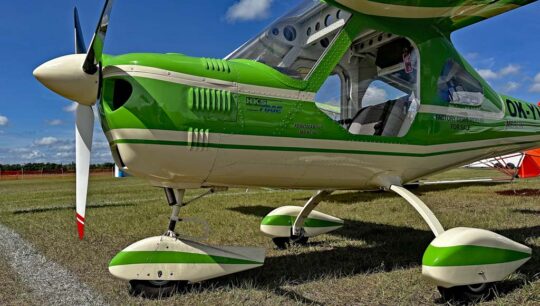



 One main reason given by Brad Damm, the company’s vice president of sales and marketing, is because customers asked for it. However, Brad has several other good reasons, which he shared in the video below.
One main reason given by Brad Damm, the company’s vice president of sales and marketing, is because customers asked for it. However, Brad has several other good reasons, which he shared in the video below. “We invested in several new technologies to make the Carbon Cub UL even lighter and better performing than its predecessor, the Carbon Cub SS,” stated CubCrafters. “The goal is a new airplane that features multi-fuel technology (mogas and/or avgas), fully meets ASTM standards, and carries two adult people with a full fuel load and a reasonable amount of baggage at a takeoff weight of 600 kilograms or 1,320 pounds.”
“We invested in several new technologies to make the Carbon Cub UL even lighter and better performing than its predecessor, the Carbon Cub SS,” stated CubCrafters. “The goal is a new airplane that features multi-fuel technology (mogas and/or avgas), fully meets ASTM standards, and carries two adult people with a full fuel load and a reasonable amount of baggage at a takeoff weight of 600 kilograms or 1,320 pounds.” “Our Carbon Cub was first introduced in 2009 and has been a successful aircraft for both CubCrafters and the entire backcountry flying community,” stated Patrick Horgan, CubCrafters President and CEO. “Now, we’re reimagining the Carbon Cub by incorporating the latest in pre-preg composites, more titanium components, and innovative manufacturing techniques, along with the best new engine and avionics technologies for even more performance and versatility.” Brad further elaborates some of these upgrades in the video below.
“Our Carbon Cub was first introduced in 2009 and has been a successful aircraft for both CubCrafters and the entire backcountry flying community,” stated Patrick Horgan, CubCrafters President and CEO. “Now, we’re reimagining the Carbon Cub by incorporating the latest in pre-preg composites, more titanium components, and innovative manufacturing techniques, along with the best new engine and avionics technologies for even more performance and versatility.” Brad further elaborates some of these upgrades in the video below. The production version of the new aircraft is slated to be initially built, certified, and test flown as a Light-Sport Aircraft at the CubCrafters factory in Yakima, Washington, but it will also meet Ultralight category requirements in many international jurisdictions.
The production version of the new aircraft is slated to be initially built, certified, and test flown as a Light-Sport Aircraft at the CubCrafters factory in Yakima, Washington, but it will also meet Ultralight category requirements in many international jurisdictions. The UL concept of a lighter and even better performing version of the Carbon Cub for international markets was first seen for a stunt in Dubai, UAE. A technology demonstrator version of the aircraft was able to successfully land and take off again from a 27-meter (about 90 foot) diameter heliport that is suspended 56 stories above the ground on top of Dubai’s iconic skyscraper, Burj Al Arab hotel as part of a recent Red Bull project that inspired audiences worldwide.
The UL concept of a lighter and even better performing version of the Carbon Cub for international markets was first seen for a stunt in Dubai, UAE. A technology demonstrator version of the aircraft was able to successfully land and take off again from a 27-meter (about 90 foot) diameter heliport that is suspended 56 stories above the ground on top of Dubai’s iconic skyscraper, Burj Al Arab hotel as part of a recent Red Bull project that inspired audiences worldwide.

 Quicksilver is now more stable than it’s been since the very beginning back in the late 1970s. That’s because in the last ownership shift, Bever and family bought the whole shebang. They purchased everything except the GT500 but covering the entire product line from the MX or Sprint/Sport series to the single seat GT400. It took several semi-truck loads to bring it all from southern California to Reserve, Louisiana.
Quicksilver is now more stable than it’s been since the very beginning back in the late 1970s. That’s because in the last ownership shift, Bever and family bought the whole shebang. They purchased everything except the GT500 but covering the entire product line from the MX or Sprint/Sport series to the single seat GT400. It took several semi-truck loads to bring it all from southern California to Reserve, Louisiana.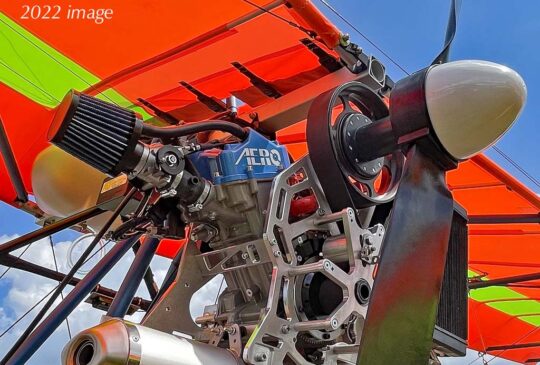 Air Tech, Inc., has a broad product and. service capability. They have all the original Quicksilver parts, many accessory items (never produced by Quicksilver, Inc.), and can aid repair on any Quicksilver model.
Air Tech, Inc., has a broad product and. service capability. They have all the original Quicksilver parts, many accessory items (never produced by Quicksilver, Inc.), and can aid repair on any Quicksilver model.
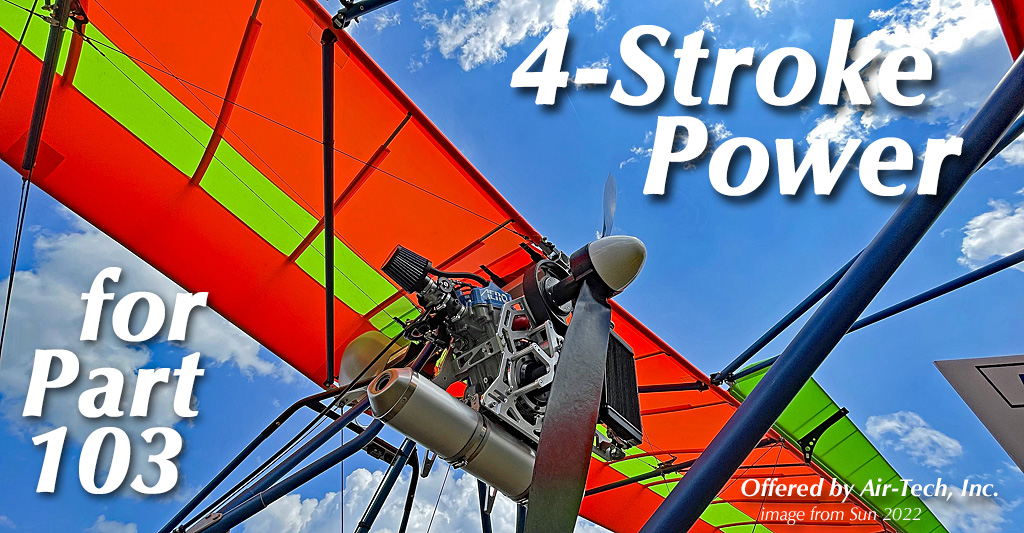

 For additional information on A50 Junior, please
For additional information on A50 Junior, please  A Swiss team was engaged to create the first example of A50 Junior in the modern age. Now that the prototyping is done and Special LSA approval has been granted from FAA, A50 can enter the U.S. market and its first buyers are already stepping up.
A Swiss team was engaged to create the first example of A50 Junior in the modern age. Now that the prototyping is done and Special LSA approval has been granted from FAA, A50 can enter the U.S. market and its first buyers are already stepping up. Junkers isn’t done. An A52 model with side-by-side seating and retractable gear could enter the market as a Mosaic LSA or mLSA. Dieter and his team are already pondering that move and, again, their U.S. factory is set up and ready to produce.
Junkers isn’t done. An A52 model with side-by-side seating and retractable gear could enter the market as a Mosaic LSA or mLSA. Dieter and his team are already pondering that move and, again, their U.S. factory is set up and ready to produce.

 How about 160 horsepower!? That’s a 19-horse or 13% gain in power, all essentially from the same engine core? With Mosaic set to allow four seaters, heavier airplanes, greater speed, and probably retractable gear, the newest 916iS seems perfectly situated for Mosaic.
How about 160 horsepower!? That’s a 19-horse or 13% gain in power, all essentially from the same engine core? With Mosaic set to allow four seaters, heavier airplanes, greater speed, and probably retractable gear, the newest 916iS seems perfectly situated for Mosaic. Rotax observed, “Our Rotax 916iS/c showcased its power for the first time in the new CubCrafters Carbon Cub UL, a new engineering prototype equipped with the 916iS.”
Rotax observed, “Our Rotax 916iS/c showcased its power for the first time in the new CubCrafters Carbon Cub UL, a new engineering prototype equipped with the 916iS.”
 However, Rotax literature specified other variations, such as the 916iS (no “c”), which they describe as the ASTM compliant engine, making them suitable for LSA today and Mosaic LSA or mLSA in 2025. The 916iS/c is certified by EASA (Europe’s rough equivalent to FAA). Commonly, reciprocal agreements between CAAs in western European nations and FAA in America allows the U.S. agency to accept EASA’s approval and vice versa.
However, Rotax literature specified other variations, such as the 916iS (no “c”), which they describe as the ASTM compliant engine, making them suitable for LSA today and Mosaic LSA or mLSA in 2025. The 916iS/c is certified by EASA (Europe’s rough equivalent to FAA). Commonly, reciprocal agreements between CAAs in western European nations and FAA in America allows the U.S. agency to accept EASA’s approval and vice versa. Since 915iS has been winning converts steadily, I predict a wonderful response to the latest and greatest from the largest supplier of light aircraft engines in the world.
Since 915iS has been winning converts steadily, I predict a wonderful response to the latest and greatest from the largest supplier of light aircraft engines in the world.


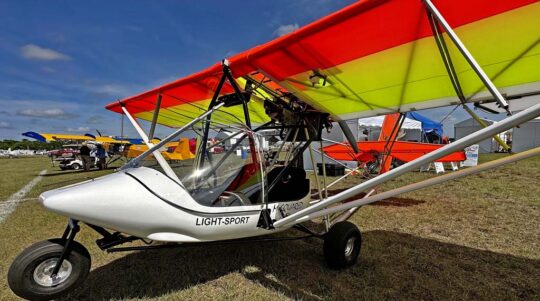 Over his many years in the business, Paul has created various models, tried a variety of engines, and strengthen (and proven) his M-Square airframe to allow more potent engines and greater carrying capacity. He has added cockpit enclosures and windscreens. You can fly all M-squared airplanes on floats.
Over his many years in the business, Paul has created various models, tried a variety of engines, and strengthen (and proven) his M-Square airframe to allow more potent engines and greater carrying capacity. He has added cockpit enclosures and windscreens. You can fly all M-squared airplanes on floats.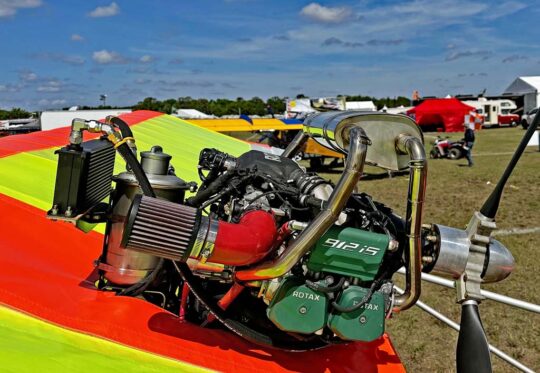 Paul and his team did a handsome installation even refitting an earlier exhaust system above the engine. They had to clear the airbox on top and keep the heat away from nearby fuel lines but this mount looked quite efficient to my eyes. Paul and I even joked that the muffler itself may produce a bit of lift as it appears somewhat airfoil shaped and operating in clean air.
Paul and his team did a handsome installation even refitting an earlier exhaust system above the engine. They had to clear the airbox on top and keep the heat away from nearby fuel lines but this mount looked quite efficient to my eyes. Paul and I even joked that the muffler itself may produce a bit of lift as it appears somewhat airfoil shaped and operating in clean air. Another major change will be the installation of a Dynon SkyView avionics. Of course, this provides many useful functions but among them Paul can now offer full ADSB In and Out. For an aircraft used to train new pilots, having such state of the air digital electronics will better prepare students.
Another major change will be the installation of a Dynon SkyView avionics. Of course, this provides many useful functions but among them Paul can now offer full ADSB In and Out. For an aircraft used to train new pilots, having such state of the air digital electronics will better prepare students.

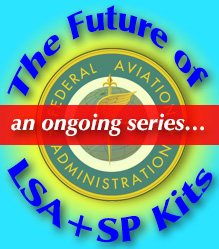 Maybe these new-fangled flying contraptions have numerous (indecipherable) names because they’re still deciding which way they’re headed?
Maybe these new-fangled flying contraptions have numerous (indecipherable) names because they’re still deciding which way they’re headed?

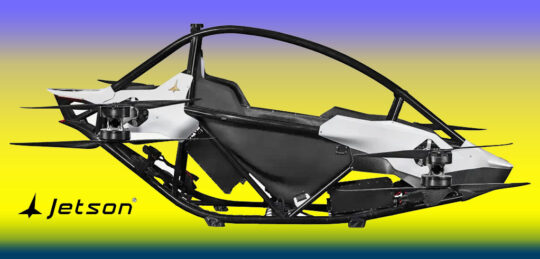 Before joining Jetson, Stéphan worked for
Before joining Jetson, Stéphan worked for 





 Some who try eventually hit upon the right formula but no one says this is easy. Technology has been particularly helpful to smaller enterprises, especially those that serve customers widely dispersed across the country. Whatever you think of social media, the fact is they help those with specialized interests find people who can provide services.
Some who try eventually hit upon the right formula but no one says this is easy. Technology has been particularly helpful to smaller enterprises, especially those that serve customers widely dispersed across the country. Whatever you think of social media, the fact is they help those with specialized interests find people who can provide services. One fellow has found his magic carpet. His instruction calendar has a few available slots in 2023 but he has already almost filled this year’s schedule book. How did one man succeed and who is this story about?
One fellow has found his magic carpet. His instruction calendar has a few available slots in 2023 but he has already almost filled this year’s schedule book. How did one man succeed and who is this story about? That work has been gratifying — and helped move the entire LSA industry forward — but Roy’s personal choice of flight and his passion is focused on powered parachutes.
That work has been gratifying — and helped move the entire LSA industry forward — but Roy’s personal choice of flight and his passion is focused on powered parachutes.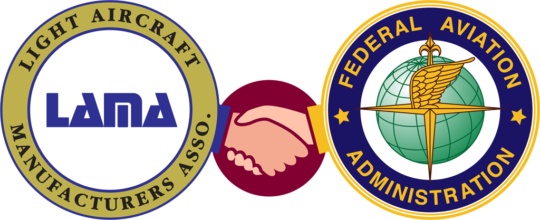 Roy’s hard work on advocacy for LSA — for which I was honored to be his partner at twisting FAA’s arm — has paid off in a big way. The coming regulation incorporates every initiative that Roy and I proposed for Mosaic.
Roy’s hard work on advocacy for LSA — for which I was honored to be his partner at twisting FAA’s arm — has paid off in a big way. The coming regulation incorporates every initiative that Roy and I proposed for Mosaic.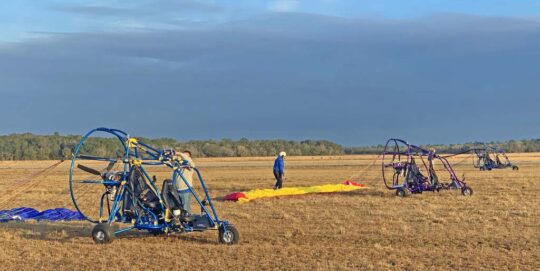 But important as this work may be, that’s enough about advocacy. Let’s talk about flying machines!
But important as this work may be, that’s enough about advocacy. Let’s talk about flying machines! Roy’s training program begins before the student gets to the airport. Anyone anywhere can start by studying a book Roy wrote on the subject. Roy’s Powered Parachute Book has 470 pages of content covering every aspect of flying powered parachutes. The inch-thick, large-format book is densely illustrated with many beautiful graphics that help explain everything. Roy admitted, “Writing a book wasn’t nearly as hard as illustrating the book.”
Roy’s training program begins before the student gets to the airport. Anyone anywhere can start by studying a book Roy wrote on the subject. Roy’s Powered Parachute Book has 470 pages of content covering every aspect of flying powered parachutes. The inch-thick, large-format book is densely illustrated with many beautiful graphics that help explain everything. Roy admitted, “Writing a book wasn’t nearly as hard as illustrating the book.”
 Thanks to a commitment to the safest practices, in the 30 years that Roy has been training powered parachutes, his program has been injury-free.
Thanks to a commitment to the safest practices, in the 30 years that Roy has been training powered parachutes, his program has been injury-free.
 As an experiment, this article was triggered by Roy asking ChatGPT to write a draft as though it was written by me. Roy tweaked it and sent it to me for final editing.
As an experiment, this article was triggered by Roy asking ChatGPT to write a draft as though it was written by me. Roy tweaked it and sent it to me for final editing.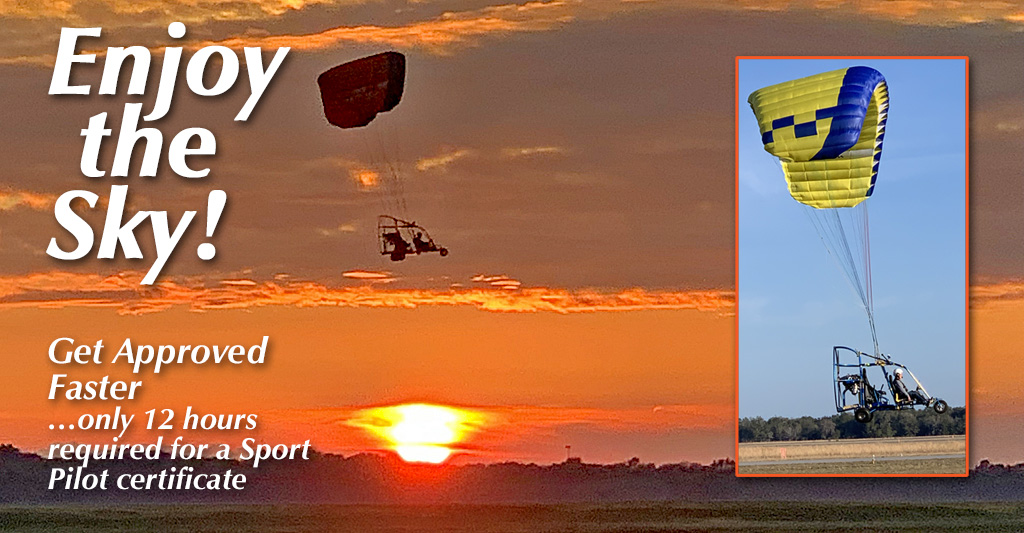
 In those two decades, LSA have arrived and flown in nearly every country on Earth.
In those two decades, LSA have arrived and flown in nearly every country on Earth. We know Chinese money is invested in (or wholly owns) many of general aviation’s top brands, including Cirrus Design, Continental Motors, Mooney, Diamond, Icon Aircraft, and others. However, money flowing to those companies does not support sales in Asia-Pacific. Most of those enterprises are mainly active in the USA and have only small operations (if any) in China or around the Pacific nations.
We know Chinese money is invested in (or wholly owns) many of general aviation’s top brands, including Cirrus Design, Continental Motors, Mooney, Diamond, Icon Aircraft, and others. However, money flowing to those companies does not support sales in Asia-Pacific. Most of those enterprises are mainly active in the USA and have only small operations (if any) in China or around the Pacific nations. AeroJones has a patient investor with a longer horizon and the company has rewarded him by steadily increasing business.
AeroJones has a patient investor with a longer horizon and the company has rewarded him by steadily increasing business. AeroJones was established in 2013 and is completing its 10th year in business, a noteworthy accomplishment it will celebrate officially in 2023.
AeroJones was established in 2013 and is completing its 10th year in business, a noteworthy accomplishment it will celebrate officially in 2023.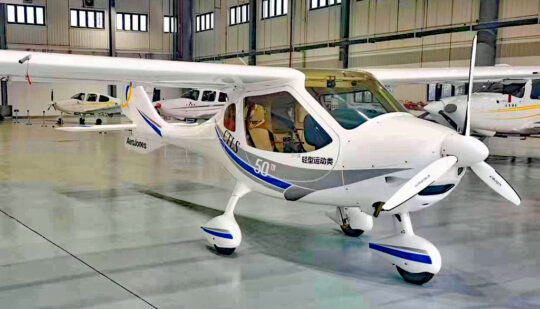 In those ten years, the AeroJones team learned to build a high-quality Light-Sport Aircraft and do so with repeatability. The company recently completed its #50 CTLS.
In those ten years, the AeroJones team learned to build a high-quality Light-Sport Aircraft and do so with repeatability. The company recently completed its #50 CTLS. Like all such producers, AeroJones does their primary assembly work using non-airport facilities. They then disassemble, transport, and reassemble their aircraft at an airport some hours away. At that location, training is conducted and newly-manufactured aircraft are test flown.
Like all such producers, AeroJones does their primary assembly work using non-airport facilities. They then disassemble, transport, and reassemble their aircraft at an airport some hours away. At that location, training is conducted and newly-manufactured aircraft are test flown. Until recently, that is the method used to deliver all light aircraft in China. It’s a large country and truck delivery adds a lot of extra work and time.
Until recently, that is the method used to deliver all light aircraft in China. It’s a large country and truck delivery adds a lot of extra work and time.
 With a delicious 10-day spacing between them — time to rest up a bit after a vigorous week — later in April comes
With a delicious 10-day spacing between them — time to rest up a bit after a vigorous week — later in April comes 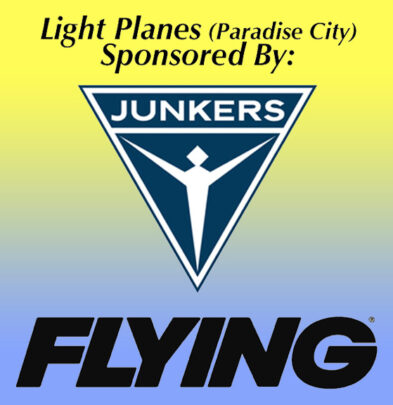 Organizers of the 49th event announced major plans for this popular airshow that kicks off the recreational flying season. My focus is on LSA, Sport Pilot kits, and ultralights. At Sun ‘n Fun, that means Paradise City, where big things are happening. You would not be wrong if you scanned this article and saw increased interest in this part of the overall Sun ‘n Fun grounds.
Organizers of the 49th event announced major plans for this popular airshow that kicks off the recreational flying season. My focus is on LSA, Sport Pilot kits, and ultralights. At Sun ‘n Fun, that means Paradise City, where big things are happening. You would not be wrong if you scanned this article and saw increased interest in this part of the overall Sun ‘n Fun grounds.

 Perhaps it is the potent combination of new leadership and bubbling pilot energy. Perhaps new attention is related to the coming Mosaic regulation. No matter, the area known to many readers as Paradise City or the Ultralight Area — or Light Planes, as Sun ‘n Fun now labels it — appears newly energized for 2023. This follows a solid year in 2022 when the overall market sector I follow was
Perhaps it is the potent combination of new leadership and bubbling pilot energy. Perhaps new attention is related to the coming Mosaic regulation. No matter, the area known to many readers as Paradise City or the Ultralight Area — or Light Planes, as Sun ‘n Fun now labels it — appears newly energized for 2023. This follows a solid year in 2022 when the overall market sector I follow was  The other sponsor is a new aircraft manufacturer,
The other sponsor is a new aircraft manufacturer,  Rotax Aircraft Engines
Rotax Aircraft Engines